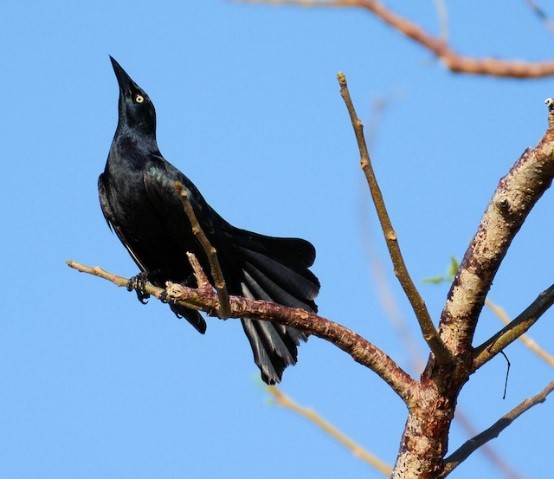Birdfinding.info ⇒ Very common and conspicuous throughout its range. Thrives in human-altered habitats. Hard to miss on any visit to the Greater Antilles.
Greater Antillean Grackle
Quiscalus niger
Endemic to the Greater Antilles: Cuba, the Cayman Islands, Jamaica, Hispaniola, Puerto Rico, and many adjacent islands such as the Isle of Youth, Gonâve, and Vieques. Common to abundant in open, lightly wooded, and settled habitats, including agricultural areas and towns.
Identification
An all-black grackle with pale eyes and a broad tail. With few exceptions, it is the only grackle in its range and thus unlikely to be misidentified.
Males are about 10% larger than females and have more noticeable iridescence: which typically appears purplish on the head and back, and bluish on the wings and tail.
Like other grackles, often holds its tail in a “keel” shape (i.e., as a V or U if viewed in cross-section). Greater Antillean’s “V” appears deeper and its tail feathers appear wider than those of other grackles.

Greater Antillean Grackle, male. (Puerto Rico; January 26, 2010.) © Dick Daniels
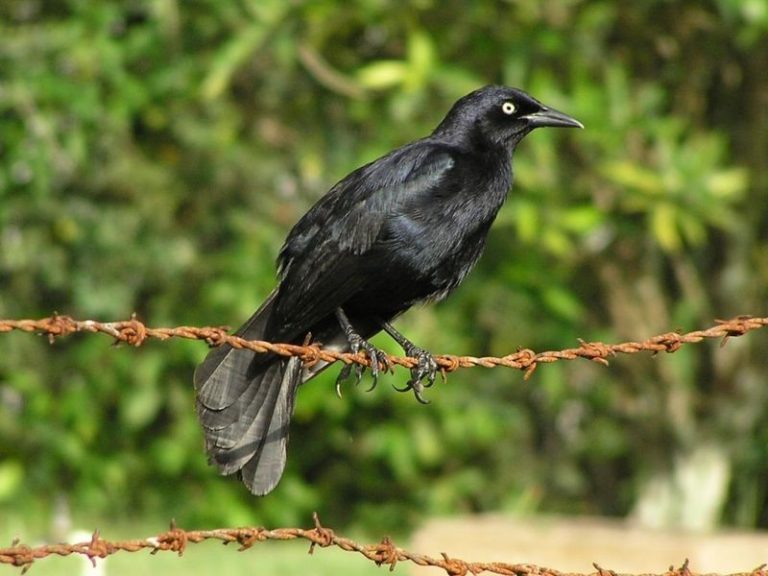
Greater Antillean Grackle. (Mona, Jamaica; May 19, 2007.) © Jan van den Broeck
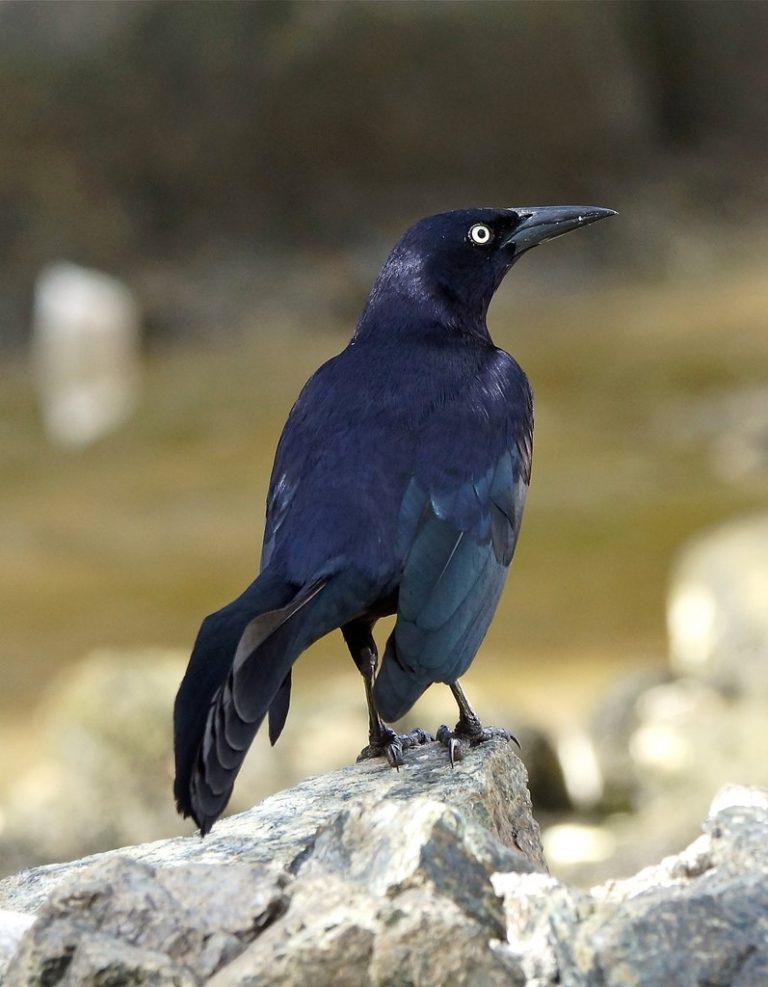
Greater Antillean Grackle, male showing tail held tight in deep, narrow V-shape. (Guardalavaca, Holguin, Cuba; January 30, 2013.) Paul
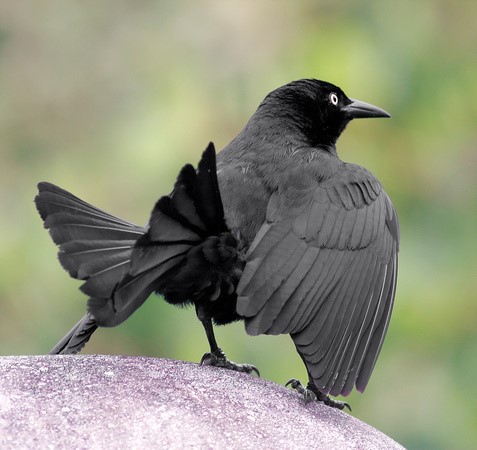
Greater Antillean Grackle, showing broad, deep keel in tail while displaying. (Puerto Rico; May 11, 2006.) © Alfredo Colón

Greater Antillean Grackle. (Queen Elizabeth II Botanic Park, Grand Cayman; December 15, 2007.) © Steve Metz

Greater Antillean Grackle, likely young male, based on small tail. (Guama, Matanzas, Cuba; April 20, 2017.) © Karl-Heinz Dohlich
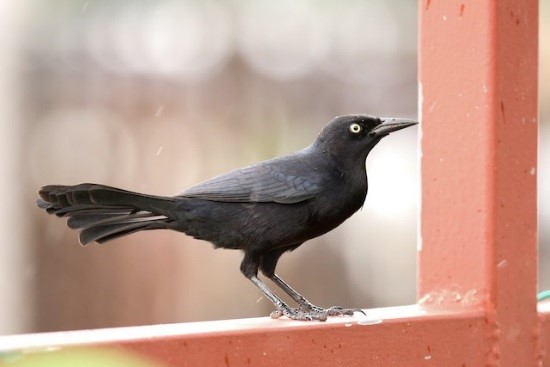
Greater Antillean Grackle, likely female (based on small tail and limited iridescence). (Aquadilla, Puerto Rico; December 5, 2016.) © Tommy Pederson

Greater Antillean Grackle. (Goblin Hill Villas, San San, Jamaica; April 13, 2014.) © Gil Ewing
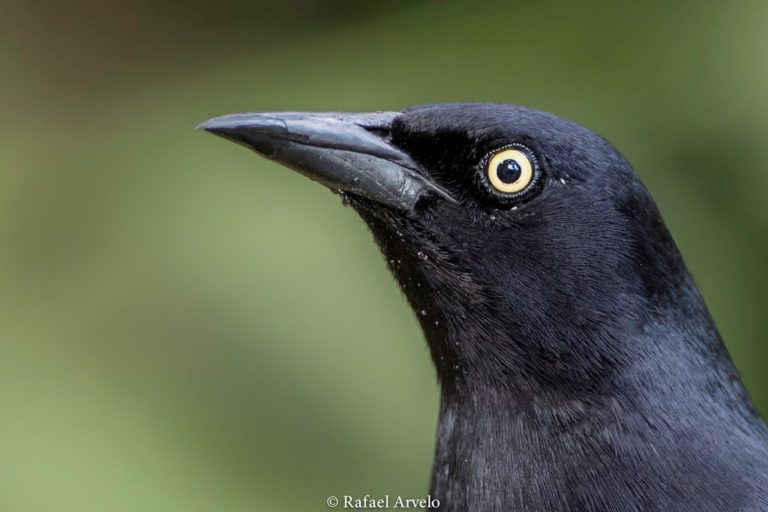
Greater Antillean Grackle. (Santo Domingo, Dominican Republic; January 11, 2016.) © Rafael V. Arvelo C.
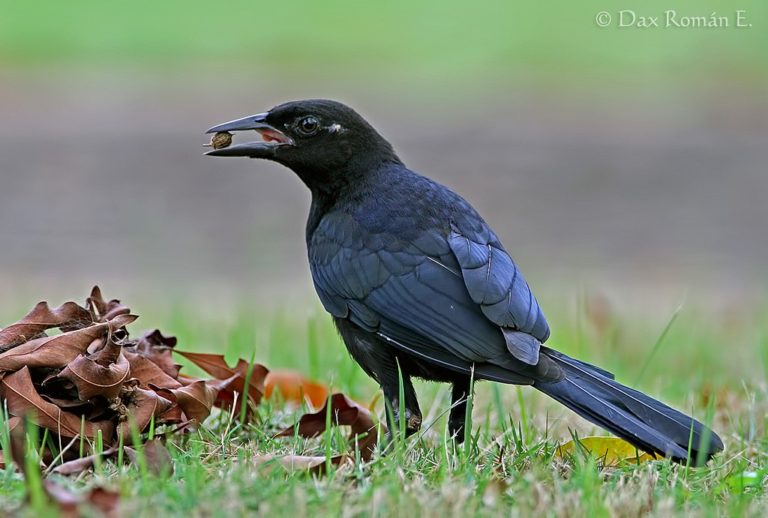
Greater Antillean Grackle, immature male (based on dark eye, narrow tail, and iridescent plumage). (National Botanical Garden, Santo Domingo, Dominican Republic; June 8, 2013.) © Dax M. Román E.
Voice. Like other grackles, Greater Antillean has a broad vocal repertoire, but it tends to be quieter, less harsh, and more musical than the other species.
Songs vary from one population to another. In some, the song is a simple series of notes:In others, a quick series of notes followed by one or more louder, metallic squawks: Groups often produce a chaotic, varied, chatter:
Cf. Common Grackle. Common Grackle is an extremely numerous migratory species that winters throughout Florida and presumably reaches Cuba at least occasionally, but is likely overlooked due to its similarity to Greater Antillean. It is also possible that Greater Antillean sometimes wanders to Florida undetected. Common’s tail is about 10% longer than and normally appears thinner than Greater Antillean’s. The two species show different patterns of iridescence.
Cf. Carib Grackle. Greater Antillean and Carib Grackles are not currently known to overlap, but both species are well adapted to human development, and the Carib Grackle’s range is expanding, so eventual contact between the two species seems likely. The male Carib is very similar to Greater Antillean (including the iridescence), but its tail is thinner and about 10-20% shorter. Female Caribs are brown (blackish in “Barbados Grackle” and some gray in the northern Lesser Antilles) and therefore readily distinguished from the jet-black Greater Antillean females.
Cf. Great-tailed Grackle. Great-tailed Grackle appears to be colonizing Jamaica and has also been found on Hispaniola. It is several inches larger than Greater Antillean, lankier overall, with a longer bill and much longer tail—over 50% longer. Great-tailed’s prodigious vocal repertoire includes a wide range of mechanical and amplifier-distortion sounds, often delivered at loud volume. Female Great-tailed is brown and therefore easily distinguished from Greater Antillean.
Notes
Polytypic species consisting of seven recognized subspecies.
References
eBird. 2019. eBird: An online database of bird distribution and abundance. Cornell Lab of Ornithology, Ithaca, N.Y. http://www.ebird.org. (Accessed January 1, 2019.)
Garrido, O.H, and A. Kirkconnell. 2000. Field Guide to the Birds of Cuba. Cornell University Press, Ithaca, N.Y.
Haynes-Sutton, A., A. Downer, R. Sutton, and Y.-J. Rey-Millet. 2009. A Photographic Guide to the Birds of Jamaica. Princeton University Press, Princeton, N.J.
Jaramillo, A., and P. Burke. 1999. New World Blackbirds: The Icterids. Princeton University Press, Princeton, N.J.
Latta, S., C. Rimmer, A. Keith, J. Wiley, H. Raffaele, K. McFarland, and E. Fernandez. 2006. Birds of the Dominican Republic and Haiti. Princeton University Press, Princeton, N.J.
Raffaele, H., J. Wiley, O. Garrido, A. Keith, and J. Raffaele. 1998. A Guide to the Birds of the West Indies. Princeton University Press, Princeton, N.J.
